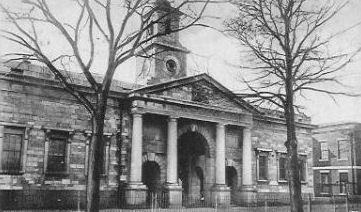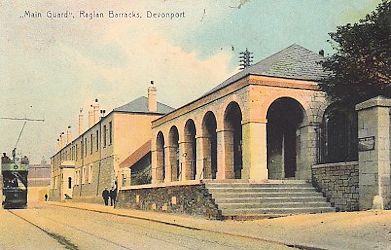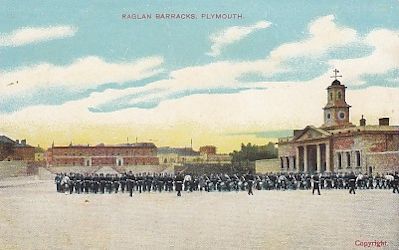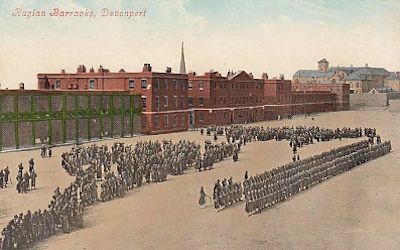|
OLD DEVONPORT
. UK |
||
|
© Brian
Moseley, Plymouth Webpage created: March 17, 2016. Webpage updated: March 18, 2020 |
||
|
RAGLAN BARRACKS
The Main gate and Clock Tower of Raglan
Barracks. Raglan Barracks was built between 1854 and 1858 on the sites of the old Frederick, Cumberland, Ligonier Squares together with portions of Piquet Barracks and Georges Square, extending from Fore Street to the north to Cumberland Road to the south.
The Main Guard of Raglan Barracks was actually
in Cumberland Road, The Barracks took their name from Lord Fitzroy James Henry Somerset (1788-1855), first Baron Raglan, who commanded the British forces at the Crimea in 1854. In July 1853 the Plymouth Times reported that Mr Clift, a Plymouth builder, had been contracted to build one wing of the barracks at a cost of £54,086 11s 8d.
A parade inside Raglan Barracks. By August the following year the Plymouth Mail said he 'is proceeding rapidly in the erection of these buildings, which, when completed, will form a considerable ornament to the Eastern entrance to the town, as well as spacious and excellent accommodation for the troops.' The work on the fortifications had been stopped for some time by the failure of the contractor but it was hoped they would be soon resumed. A military road was to be constructed from the foot of Stonehouse Hill to the Eastern Barrier.
When troops were reviewed inside Raglan
Barracks they had a public audience. Notice was given in October 1855 that the Ordnance Office would be taking the block of buildings including the Ordnance Inn, the Temperance Hotel, the Hope Chapel (which was only opened the previous year) and other dwelling houses in Fore Street, as far down as Mr Arnold's ironmongery establishment, as well as houses in Saint Andrew's Lane, for the construction of the Barracks. About a half of the Barracks was completed by May 1857, it was reported, and the gas lighting was turned on during the week of May 11th 1857. The apparatus had been installed by Messrs Chafe and Condy, of Devonport, and Mr Thomas Westlake, brass-founder, of Frankfort Street, Plymouth. There was no formal opening of the Barracks. The first soldiers to march through the gate in Chapel Street were the men of the 96th Regiment of Foot, who in full dress (scarlet tunics with yellow facings) and under the command of Lieutenant-Colonel E W Scovell, entered Raglan Barracks on December 24th 1858. They were preceded by the regimental band under the musical direction of Signor Tamplini. In the Army reorganisation of 1881 they became the 2nd Battalion, Manchester Regiment. Raglan Barracks was constructed of yellow bricks and had flat roofs and lengthy verandas. The style gave rise to the story that the plans had been destined for a tropical location and came to Devonport by mistake. It was lit by over 1,000 gas jets. The buildings contained messes for officers and sergeants, a library, recreations rooms and vastly improved kitchens. In the married quarters, which were on the site of the former George Square, a married sergeant was allowed two rooms and a married private one room. The kitchens and wash-houses were communal. It was built to accommodate two entire regiments of the line, or 2,000 men and 80 officers. The Garrison Church of Saint Michael and Saint George was detached, situated as it was on the south side of Cumberland Road. It could seat over 1,000 men for Divine Service on Sundays. Just to the rear of the Church was the gymnasium and a building now known as the Picquet Barracks. It is thought to have derived its name from the card game, "Piquet", which was probably played in this building by the officers of the Garrison. When the Rifle Volunteers were instituted in 1860 the Devonport Rifle Corps held its first muster in their dark green Rifleman's uniform on the parade ground at Raglan Barracks before marching proudly through the Town led by the band of the 36th regiment of Foot (later to become the 2nd Battalion Worcestershire Regiment. In October 1899, at the commencement of the Boer War, the regiments stationed at Raglan were 1st Battalion Oxfordshire and Buckingham Light Infantry, commanded by Lieutenant-Colonel J A Strachan, and the 2nd Battalion Devon & Cornwall Light Infantry, under Lieutenant-Colonel W Aldworth. They both left to take part in the Boer War. On Friday July 10th 1908 it was suddenly announced that the provision of a guard at the Main Guard in Cumberland Road was to cease from midnight and from July 11th anybody needing to visit the Military Families' Hospital would have to ring the bell now provided on the hospital gate. At the outbreak of the Great War the 2nd Royal Irish Regiment, or 18th Regiment of Foot, and the 4th Middlesex were stationed at Raglan barracks. The first-named was commanded by Lieutenant-Colonel Saint J A Cox and the second by Lieutenant-Colonel Charles P Amyatt Hull. In 1936 the War Department announced that Raglan Barracks was out-of-date and should be demolished. It was intended to build a new barracks in the Tavistock area. Work on South Raglan had just started when the Second World War broke out in 1939. The North Block was at that time occupied by the 2nd Royal Sussex Regiment, under Lieutenant-Colonel M A James VC MC. When the War ended the Barracks was given superficial repairs and used to house a government department and as headquarters for a few of the local Territorial and Auxiliary Forces. Various plans to rebuild the Barracks fell by the wayside in post-war cut-backs until, in 1967, it was announced that he Territorial Army was to be phased out. The South Raglan block was still occupied by the Civil Service.
Raglan Barracks has been demolished apart from the main
gateway. |
||



